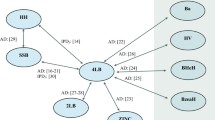Abstract
The concern of this work is the statistical evaluation of healing rate of gastric ulcers. To measure healing progress, the distance of linear advance of a specific ulcer margin toward center is recommended as an appropriate parameter. The sequence of linear advances is approximately linear over time; thus, the slope of this linear profile provides a good indication of the healing rate of the specific ulcer area. To estimate the mean slope in a treatment group, the mixed effects model technique is employed. A treatment effects comparison is made by both the F-test and the likelihood ratio test for a common slope across treatments. Also discussed are the advantages of using the linear advance as an endpoint and the mixed effects model technique as an analysis tool. A numerical example is presented as an illustration.
Similar content being viewed by others
References
Poynard T. Pignon U-P. Duodenal ulcer. Analyses of 93 randomized clinical trials. London and Paris: John Libbey Eurotext; 1989.
Pecoraro RE. et al. Chronology and Determinants of Tissue Repair in Diabetic Lower-Extremity Ulcers. Diabetes. 1991;40:1305–1313.
Gilman TH. Parameter for Measurement of Wound Closure. Wounds. 1990;2(3):May/June 95–101.
Margolis DM, et al. Planimetric rate of healing in venous ulcers of the leg treated with pressure bandage and hydrocolloid dressing. J Am Acad Dermatol. 1993;28(3):418–421.
Laird NM. Ware JH. Random-effects models for longitudinal data. Biometrics. 1982;38(4):963–974.
SAS/STAT Software Changes and Enhancements through Release 6.11. Cary, NC: SAS Institute Inc.; 1996.
Advanced General Linear Models with and Emphasis on Mixed Models Course Notes. Cary, NC: SAS Institute Inc.; 1996.
Jennrich RI. Schluchter MD. Unbalanced Repeated-Measures Models with Structured Covariance Matrices. Biometrics. 1986;42;805–820.
Gornbein JA. Laxaro CG, Little RJA. Incomplete data in repeated measures analysis. Stat methods Med Res. 1992;1:275–295.
Author information
Authors and Affiliations
Rights and permissions
About this article
Cite this article
Zhang, D. A Mixed Effects Model for Gastric Ulcer Data. Ther Innov Regul Sci 31, 1249–1254 (1997). https://doi.org/10.1177/009286159703100425
Published:
Issue Date:
DOI: https://doi.org/10.1177/009286159703100425




